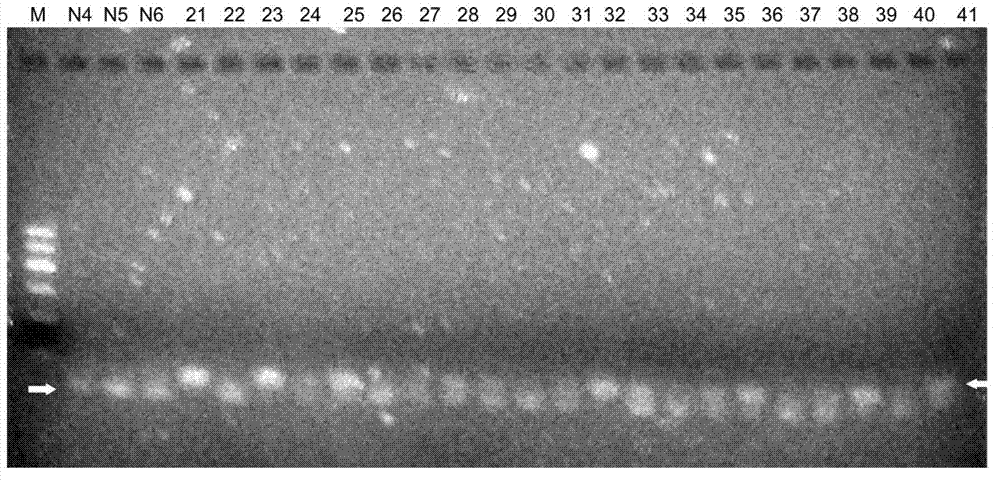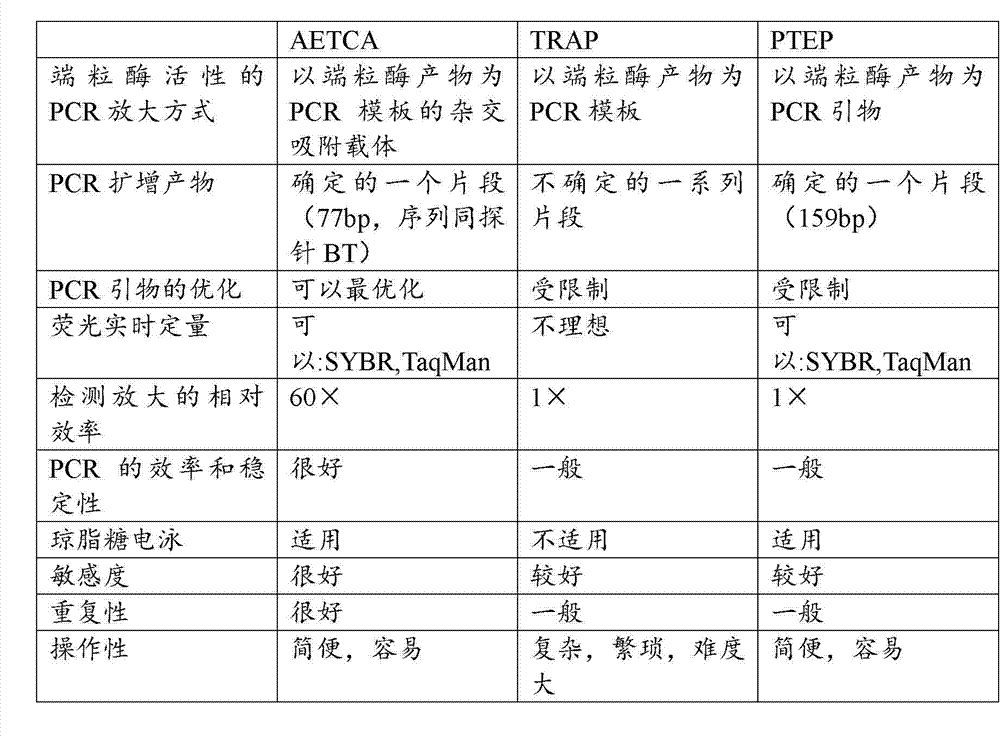AETCA (anchored-extension and telomeric complements amplification) detection reagent kit for telomerase and detection method
A detection kit, telomerase technology, applied in the direction of microbial determination/inspection, biochemical equipment and methods, etc., can solve the problems of reduced sensitivity, limited applicability, difficult quantitative PCR, etc., to improve sensitivity and specificity , the operation is simple and easy, and the effect of improving the amplification efficiency
- Summary
- Abstract
- Description
- Claims
- Application Information
AI Technical Summary
Problems solved by technology
Method used
Image
Examples
Embodiment 1
[0052] Example 1: Washing to remove non-fixed probe BT
[0053] 50ul extension hybridization buffer, in which 1nmol / L probe BT was added, was added to a 0.2ml PCR thin-walled tube, incubated at 25°C for 10min, and incubated at 55~70°C for 5~15min, then blotted the liquid in the tube, and used TBST Wash with buffer solution for 1, 3, 5, 7, 9 or 12 times, add 50ul PCR reaction solution, and perform PCR program (94°C 3min pre-denaturation, then 40 cycles of 94°C 3s, 66°C 30s, two-step method), SYBR green I fluorescence quantitative analysis, the results are shown in the table below. The results showed that the number of washes reached and exceeded 5 times, and the probe BT no longer had a stronger amplification signal than the blank control (the Ct value was equivalent to that of the blank), indicating that the washing step could completely wash away unbound probe DNA.
[0054] Composition of PCR reaction solution: 50mmol / L KCl, 1.5mmol / L MgCl 2 , 0.2mmol / L dNTP, 5% DMSO, 0.05%...
Embodiment 2
[0060] Example 2: Fabrication of anchor tubes by magnetic bead method
[0061]TBST buffer 20ul, containing 10ug Dynabeads? M-280 streptavidin magnetic beads and 2pmol biotinylated telomerase primer ATS (biotin is modified to the 5' end when the primer is synthesized), loaded into 0.2ml PCR In a thin-walled tube, at room temperature for 1 hr, use a magnet to adsorb the magnetic beads on the tube wall, blot the liquid in the tube, add 50ul TBST buffer, mix well, blot dry, and wash repeatedly in this way for a total of 6 times, and finally blot dry; add 50ul TE Buffer solution, and then use a magnet to adsorb the magnetic beads in the tube wall, blot the liquid in the tube, add 20ul cell lysate supernatant (A549 cells are cultured in a 24-well plate (10~10000 cells / well), and absorb the culture solution , + 200ul lysis buffer, pipette repeatedly, transfer to a 1.5 ml centrifuge tube, place on ice for 20 minutes, centrifuge at 4°C, 15000 rpm for 20 minutes, take the supernatant to...
Embodiment 3
[0063] Embodiment 3: direct PCR in-tube coupling method makes anchor tube
[0064] TBST buffer 50ul, containing 5pmol biotinylated telomerase primer ATS, put into a streptavidin-coated 0.2ml PCR thin-walled tube, room temperature for 1hr, blot the liquid in the tube, add 100ul TBST buffer, and pour Mix well, blot dry, wash repeatedly in this way for a total of 3 times, and finally blot dry; add 100ul TE buffer, then blot the liquid in the tube, add 50ul cell lysate supernatant (same as Example 2), leave at room temperature for 1hr, blot dry, Add 40ul extension hybridization buffer (containing 0.1nmol / L probe BT), then add 10ul cell lysate supernatant, incubate at 30°C for 30min, and incubate at 64°C for 10min, then blot the liquid in the tube, wash 7 times with TBST buffer, Add 50ul of PCR reaction solution (same as Example 1), perform PCR program (93°C 3min pre-denaturation, then 40 cycles of 93°C 3s, 62°C 30s, two-step method), SYBR fluorescence quantitative analysis, the re...
PUM
 Login to View More
Login to View More Abstract
Description
Claims
Application Information
 Login to View More
Login to View More - R&D
- Intellectual Property
- Life Sciences
- Materials
- Tech Scout
- Unparalleled Data Quality
- Higher Quality Content
- 60% Fewer Hallucinations
Browse by: Latest US Patents, China's latest patents, Technical Efficacy Thesaurus, Application Domain, Technology Topic, Popular Technical Reports.
© 2025 PatSnap. All rights reserved.Legal|Privacy policy|Modern Slavery Act Transparency Statement|Sitemap|About US| Contact US: help@patsnap.com



